Analysis of Leadership and Management Theories in the NHS Context
VerifiedAdded on 2023/01/12
|15
|4672
|100
Essay
AI Summary
This essay provides an understanding of leadership and management concepts, exploring various leadership theories and their application within the NHS (National Health Service). It differentiates between leadership and management, highlighting their similarities and differences in the context of organizational goals. The essay also delves into specific leadership theories such as trait theory and behavioral theory, discussing their advantages and disadvantages in relation to leadership effectiveness within an organization like the NHS. The importance of leadership development programs is emphasized, along with the role of leaders in motivating employees, making strategic decisions, and fostering a positive working environment to achieve organizational objectives. The essay concludes by reinforcing the critical roles of both leadership and management in ensuring the success and sustainability of organizations.
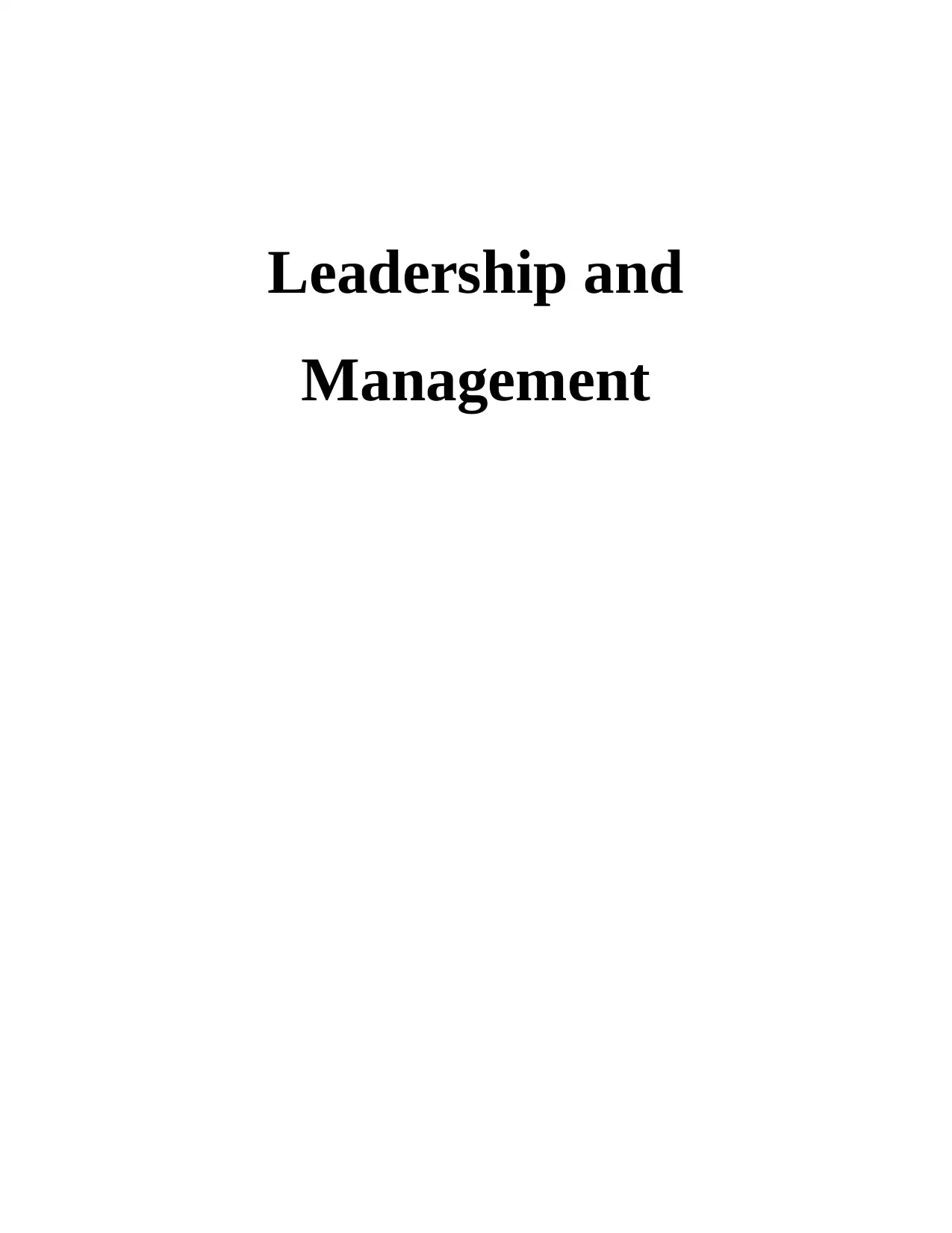
Leadership and
Management
Management
Paraphrase This Document
Need a fresh take? Get an instant paraphrase of this document with our AI Paraphraser
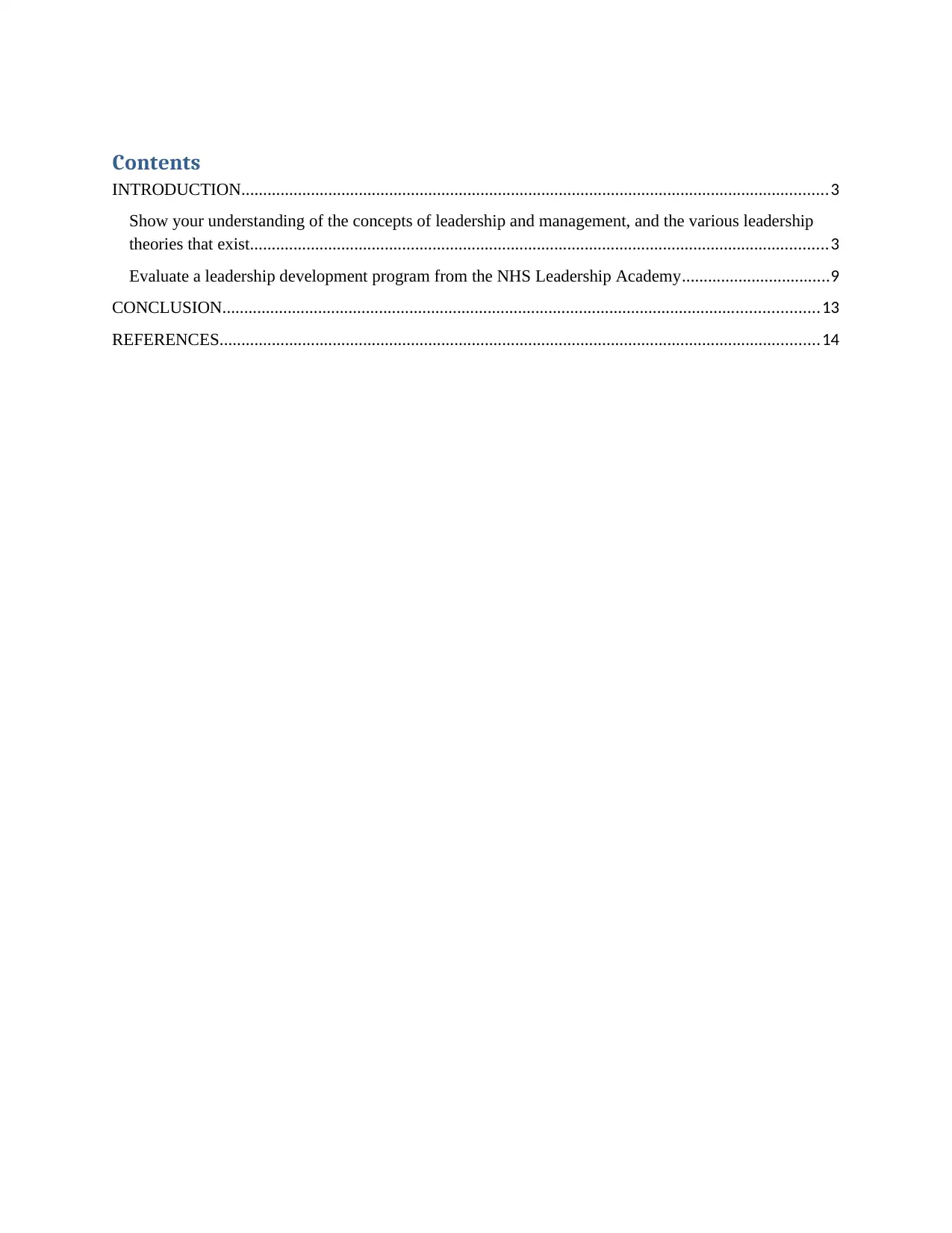
Contents
INTRODUCTION.......................................................................................................................................3
Show your understanding of the concepts of leadership and management, and the various leadership
theories that exist.....................................................................................................................................3
Evaluate a leadership development program from the NHS Leadership Academy..................................9
CONCLUSION.........................................................................................................................................13
REFERENCES..........................................................................................................................................14
INTRODUCTION.......................................................................................................................................3
Show your understanding of the concepts of leadership and management, and the various leadership
theories that exist.....................................................................................................................................3
Evaluate a leadership development program from the NHS Leadership Academy..................................9
CONCLUSION.........................................................................................................................................13
REFERENCES..........................................................................................................................................14
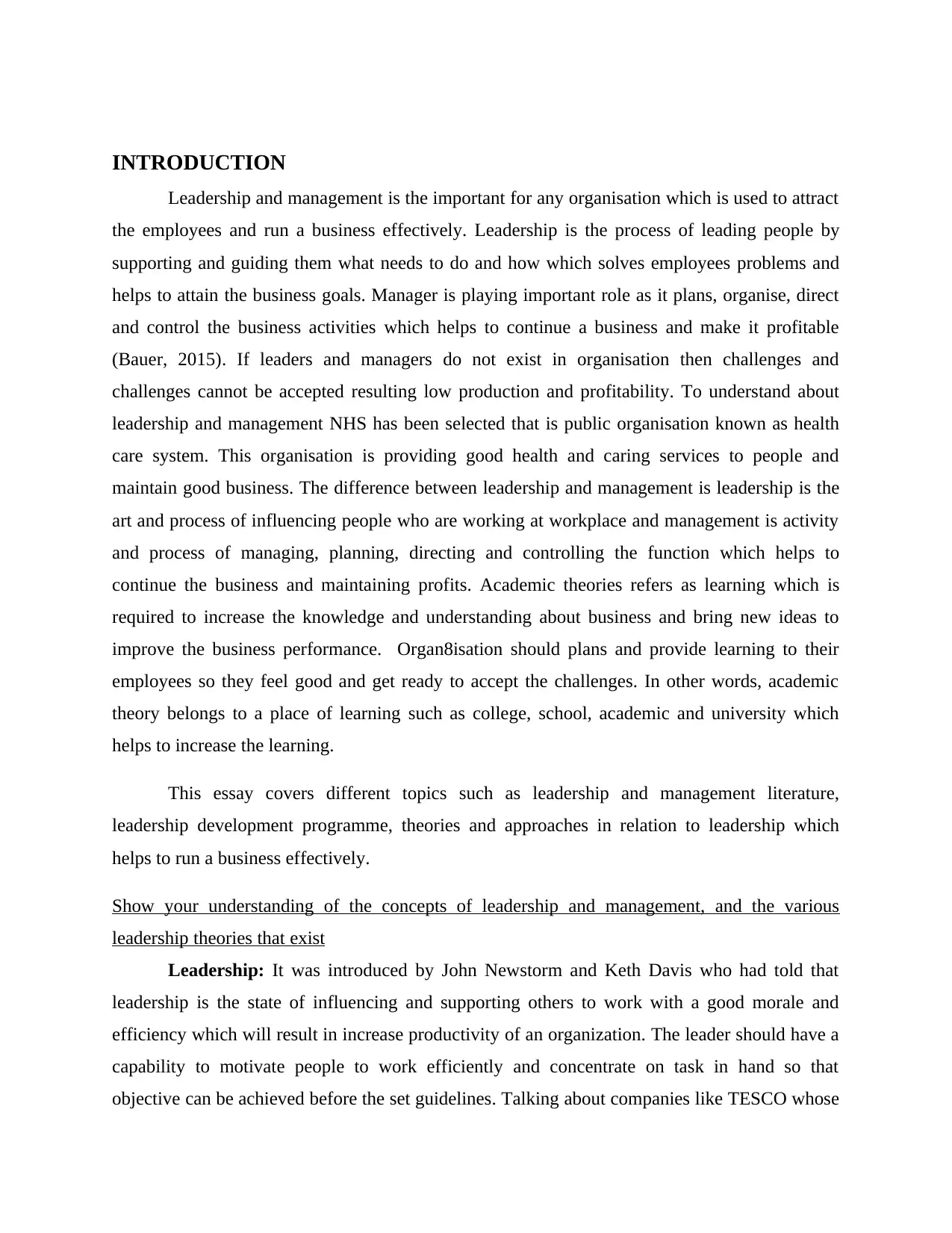
INTRODUCTION
Leadership and management is the important for any organisation which is used to attract
the employees and run a business effectively. Leadership is the process of leading people by
supporting and guiding them what needs to do and how which solves employees problems and
helps to attain the business goals. Manager is playing important role as it plans, organise, direct
and control the business activities which helps to continue a business and make it profitable
(Bauer, 2015). If leaders and managers do not exist in organisation then challenges and
challenges cannot be accepted resulting low production and profitability. To understand about
leadership and management NHS has been selected that is public organisation known as health
care system. This organisation is providing good health and caring services to people and
maintain good business. The difference between leadership and management is leadership is the
art and process of influencing people who are working at workplace and management is activity
and process of managing, planning, directing and controlling the function which helps to
continue the business and maintaining profits. Academic theories refers as learning which is
required to increase the knowledge and understanding about business and bring new ideas to
improve the business performance. Organ8isation should plans and provide learning to their
employees so they feel good and get ready to accept the challenges. In other words, academic
theory belongs to a place of learning such as college, school, academic and university which
helps to increase the learning.
This essay covers different topics such as leadership and management literature,
leadership development programme, theories and approaches in relation to leadership which
helps to run a business effectively.
Show your understanding of the concepts of leadership and management, and the various
leadership theories that exist
Leadership: It was introduced by John Newstorm and Keth Davis who had told that
leadership is the state of influencing and supporting others to work with a good morale and
efficiency which will result in increase productivity of an organization. The leader should have a
capability to motivate people to work efficiently and concentrate on task in hand so that
objective can be achieved before the set guidelines. Talking about companies like TESCO whose
Leadership and management is the important for any organisation which is used to attract
the employees and run a business effectively. Leadership is the process of leading people by
supporting and guiding them what needs to do and how which solves employees problems and
helps to attain the business goals. Manager is playing important role as it plans, organise, direct
and control the business activities which helps to continue a business and make it profitable
(Bauer, 2015). If leaders and managers do not exist in organisation then challenges and
challenges cannot be accepted resulting low production and profitability. To understand about
leadership and management NHS has been selected that is public organisation known as health
care system. This organisation is providing good health and caring services to people and
maintain good business. The difference between leadership and management is leadership is the
art and process of influencing people who are working at workplace and management is activity
and process of managing, planning, directing and controlling the function which helps to
continue the business and maintaining profits. Academic theories refers as learning which is
required to increase the knowledge and understanding about business and bring new ideas to
improve the business performance. Organ8isation should plans and provide learning to their
employees so they feel good and get ready to accept the challenges. In other words, academic
theory belongs to a place of learning such as college, school, academic and university which
helps to increase the learning.
This essay covers different topics such as leadership and management literature,
leadership development programme, theories and approaches in relation to leadership which
helps to run a business effectively.
Show your understanding of the concepts of leadership and management, and the various
leadership theories that exist
Leadership: It was introduced by John Newstorm and Keth Davis who had told that
leadership is the state of influencing and supporting others to work with a good morale and
efficiency which will result in increase productivity of an organization. The leader should have a
capability to motivate people to work efficiently and concentrate on task in hand so that
objective can be achieved before the set guidelines. Talking about companies like TESCO whose
⊘ This is a preview!⊘
Do you want full access?
Subscribe today to unlock all pages.

Trusted by 1+ million students worldwide
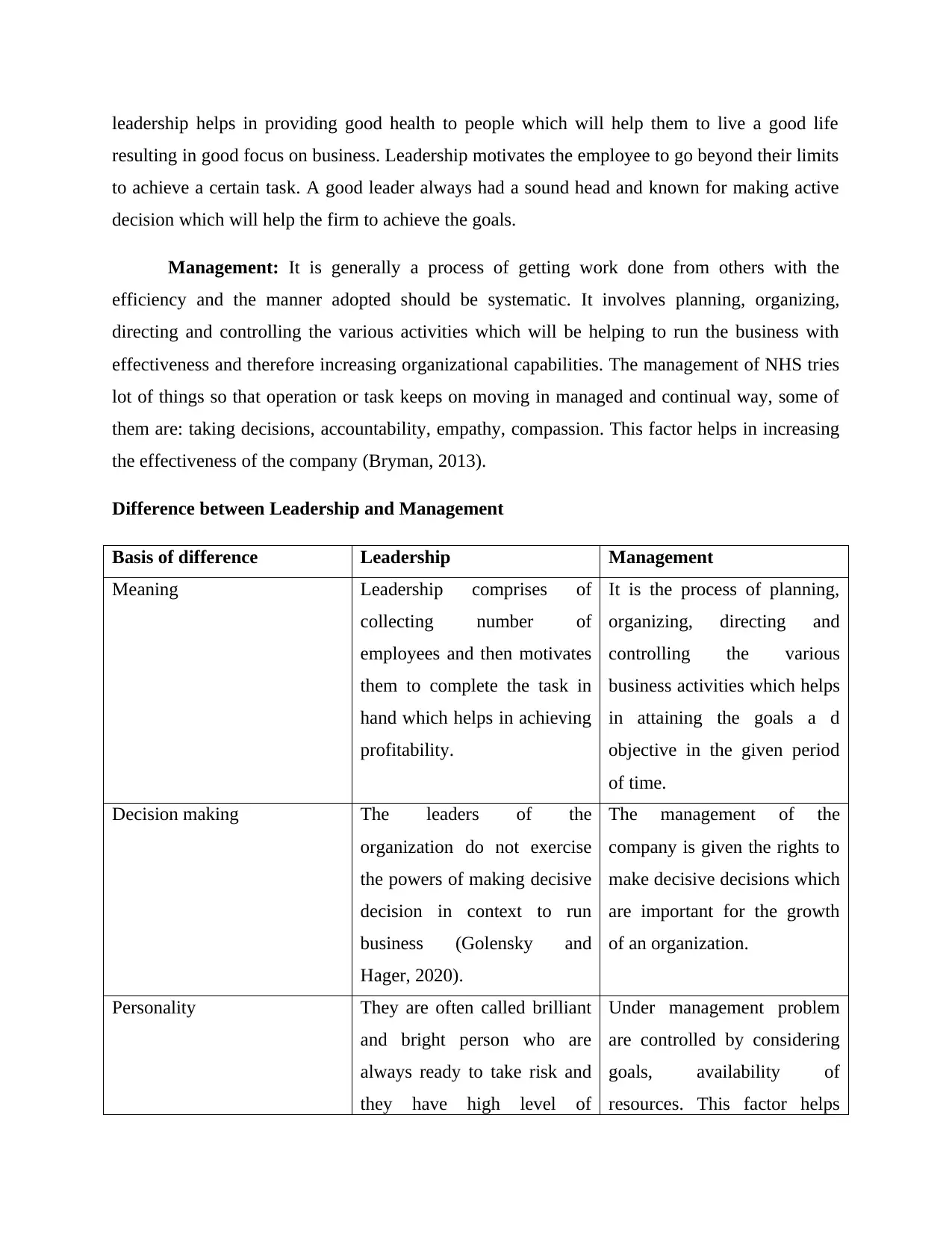
leadership helps in providing good health to people which will help them to live a good life
resulting in good focus on business. Leadership motivates the employee to go beyond their limits
to achieve a certain task. A good leader always had a sound head and known for making active
decision which will help the firm to achieve the goals.
Management: It is generally a process of getting work done from others with the
efficiency and the manner adopted should be systematic. It involves planning, organizing,
directing and controlling the various activities which will be helping to run the business with
effectiveness and therefore increasing organizational capabilities. The management of NHS tries
lot of things so that operation or task keeps on moving in managed and continual way, some of
them are: taking decisions, accountability, empathy, compassion. This factor helps in increasing
the effectiveness of the company (Bryman, 2013).
Difference between Leadership and Management
Basis of difference Leadership Management
Meaning Leadership comprises of
collecting number of
employees and then motivates
them to complete the task in
hand which helps in achieving
profitability.
It is the process of planning,
organizing, directing and
controlling the various
business activities which helps
in attaining the goals a d
objective in the given period
of time.
Decision making The leaders of the
organization do not exercise
the powers of making decisive
decision in context to run
business (Golensky and
Hager, 2020).
The management of the
company is given the rights to
make decisive decisions which
are important for the growth
of an organization.
Personality They are often called brilliant
and bright person who are
always ready to take risk and
they have high level of
Under management problem
are controlled by considering
goals, availability of
resources. This factor helps
resulting in good focus on business. Leadership motivates the employee to go beyond their limits
to achieve a certain task. A good leader always had a sound head and known for making active
decision which will help the firm to achieve the goals.
Management: It is generally a process of getting work done from others with the
efficiency and the manner adopted should be systematic. It involves planning, organizing,
directing and controlling the various activities which will be helping to run the business with
effectiveness and therefore increasing organizational capabilities. The management of NHS tries
lot of things so that operation or task keeps on moving in managed and continual way, some of
them are: taking decisions, accountability, empathy, compassion. This factor helps in increasing
the effectiveness of the company (Bryman, 2013).
Difference between Leadership and Management
Basis of difference Leadership Management
Meaning Leadership comprises of
collecting number of
employees and then motivates
them to complete the task in
hand which helps in achieving
profitability.
It is the process of planning,
organizing, directing and
controlling the various
business activities which helps
in attaining the goals a d
objective in the given period
of time.
Decision making The leaders of the
organization do not exercise
the powers of making decisive
decision in context to run
business (Golensky and
Hager, 2020).
The management of the
company is given the rights to
make decisive decisions which
are important for the growth
of an organization.
Personality They are often called brilliant
and bright person who are
always ready to take risk and
they have high level of
Under management problem
are controlled by considering
goals, availability of
resources. This factor helps
Paraphrase This Document
Need a fresh take? Get an instant paraphrase of this document with our AI Paraphraser
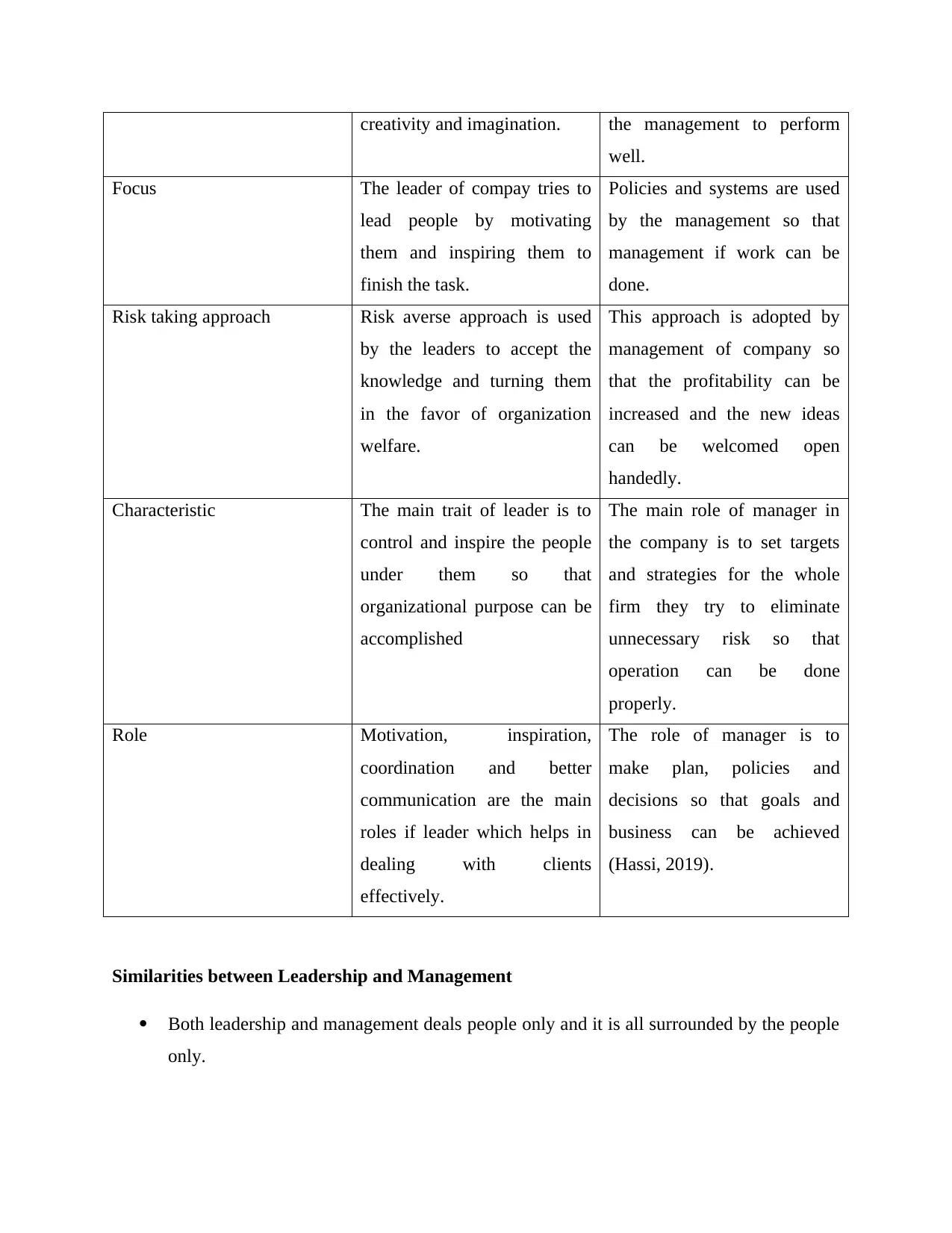
creativity and imagination. the management to perform
well.
Focus The leader of compay tries to
lead people by motivating
them and inspiring them to
finish the task.
Policies and systems are used
by the management so that
management if work can be
done.
Risk taking approach Risk averse approach is used
by the leaders to accept the
knowledge and turning them
in the favor of organization
welfare.
This approach is adopted by
management of company so
that the profitability can be
increased and the new ideas
can be welcomed open
handedly.
Characteristic The main trait of leader is to
control and inspire the people
under them so that
organizational purpose can be
accomplished
The main role of manager in
the company is to set targets
and strategies for the whole
firm they try to eliminate
unnecessary risk so that
operation can be done
properly.
Role Motivation, inspiration,
coordination and better
communication are the main
roles if leader which helps in
dealing with clients
effectively.
The role of manager is to
make plan, policies and
decisions so that goals and
business can be achieved
(Hassi, 2019).
Similarities between Leadership and Management
Both leadership and management deals people only and it is all surrounded by the people
only.
well.
Focus The leader of compay tries to
lead people by motivating
them and inspiring them to
finish the task.
Policies and systems are used
by the management so that
management if work can be
done.
Risk taking approach Risk averse approach is used
by the leaders to accept the
knowledge and turning them
in the favor of organization
welfare.
This approach is adopted by
management of company so
that the profitability can be
increased and the new ideas
can be welcomed open
handedly.
Characteristic The main trait of leader is to
control and inspire the people
under them so that
organizational purpose can be
accomplished
The main role of manager in
the company is to set targets
and strategies for the whole
firm they try to eliminate
unnecessary risk so that
operation can be done
properly.
Role Motivation, inspiration,
coordination and better
communication are the main
roles if leader which helps in
dealing with clients
effectively.
The role of manager is to
make plan, policies and
decisions so that goals and
business can be achieved
(Hassi, 2019).
Similarities between Leadership and Management
Both leadership and management deals people only and it is all surrounded by the people
only.
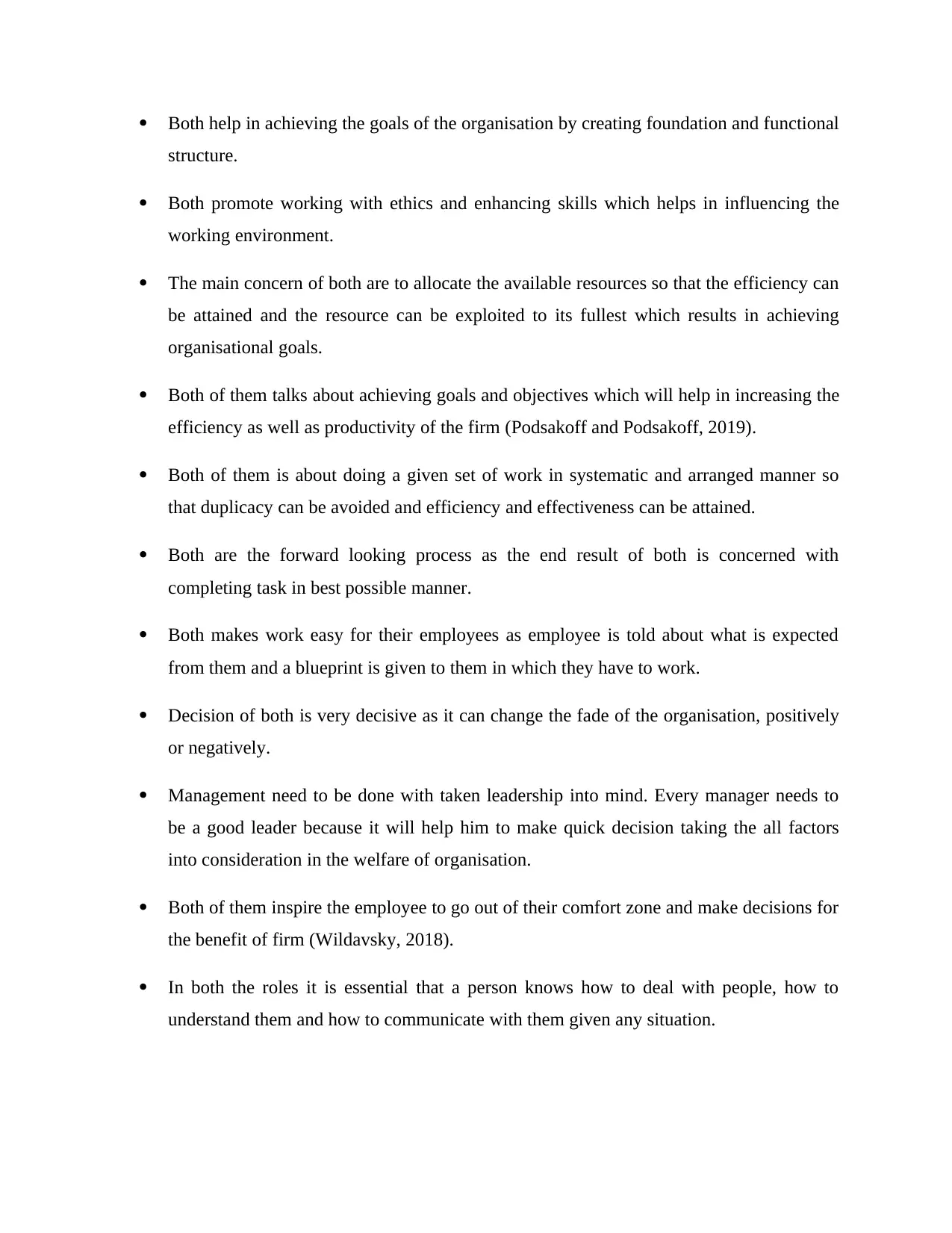
Both help in achieving the goals of the organisation by creating foundation and functional
structure.
Both promote working with ethics and enhancing skills which helps in influencing the
working environment.
The main concern of both are to allocate the available resources so that the efficiency can
be attained and the resource can be exploited to its fullest which results in achieving
organisational goals.
Both of them talks about achieving goals and objectives which will help in increasing the
efficiency as well as productivity of the firm (Podsakoff and Podsakoff, 2019).
Both of them is about doing a given set of work in systematic and arranged manner so
that duplicacy can be avoided and efficiency and effectiveness can be attained.
Both are the forward looking process as the end result of both is concerned with
completing task in best possible manner.
Both makes work easy for their employees as employee is told about what is expected
from them and a blueprint is given to them in which they have to work.
Decision of both is very decisive as it can change the fade of the organisation, positively
or negatively.
Management need to be done with taken leadership into mind. Every manager needs to
be a good leader because it will help him to make quick decision taking the all factors
into consideration in the welfare of organisation.
Both of them inspire the employee to go out of their comfort zone and make decisions for
the benefit of firm (Wildavsky, 2018).
In both the roles it is essential that a person knows how to deal with people, how to
understand them and how to communicate with them given any situation.
structure.
Both promote working with ethics and enhancing skills which helps in influencing the
working environment.
The main concern of both are to allocate the available resources so that the efficiency can
be attained and the resource can be exploited to its fullest which results in achieving
organisational goals.
Both of them talks about achieving goals and objectives which will help in increasing the
efficiency as well as productivity of the firm (Podsakoff and Podsakoff, 2019).
Both of them is about doing a given set of work in systematic and arranged manner so
that duplicacy can be avoided and efficiency and effectiveness can be attained.
Both are the forward looking process as the end result of both is concerned with
completing task in best possible manner.
Both makes work easy for their employees as employee is told about what is expected
from them and a blueprint is given to them in which they have to work.
Decision of both is very decisive as it can change the fade of the organisation, positively
or negatively.
Management need to be done with taken leadership into mind. Every manager needs to
be a good leader because it will help him to make quick decision taking the all factors
into consideration in the welfare of organisation.
Both of them inspire the employee to go out of their comfort zone and make decisions for
the benefit of firm (Wildavsky, 2018).
In both the roles it is essential that a person knows how to deal with people, how to
understand them and how to communicate with them given any situation.
⊘ This is a preview!⊘
Do you want full access?
Subscribe today to unlock all pages.

Trusted by 1+ million students worldwide
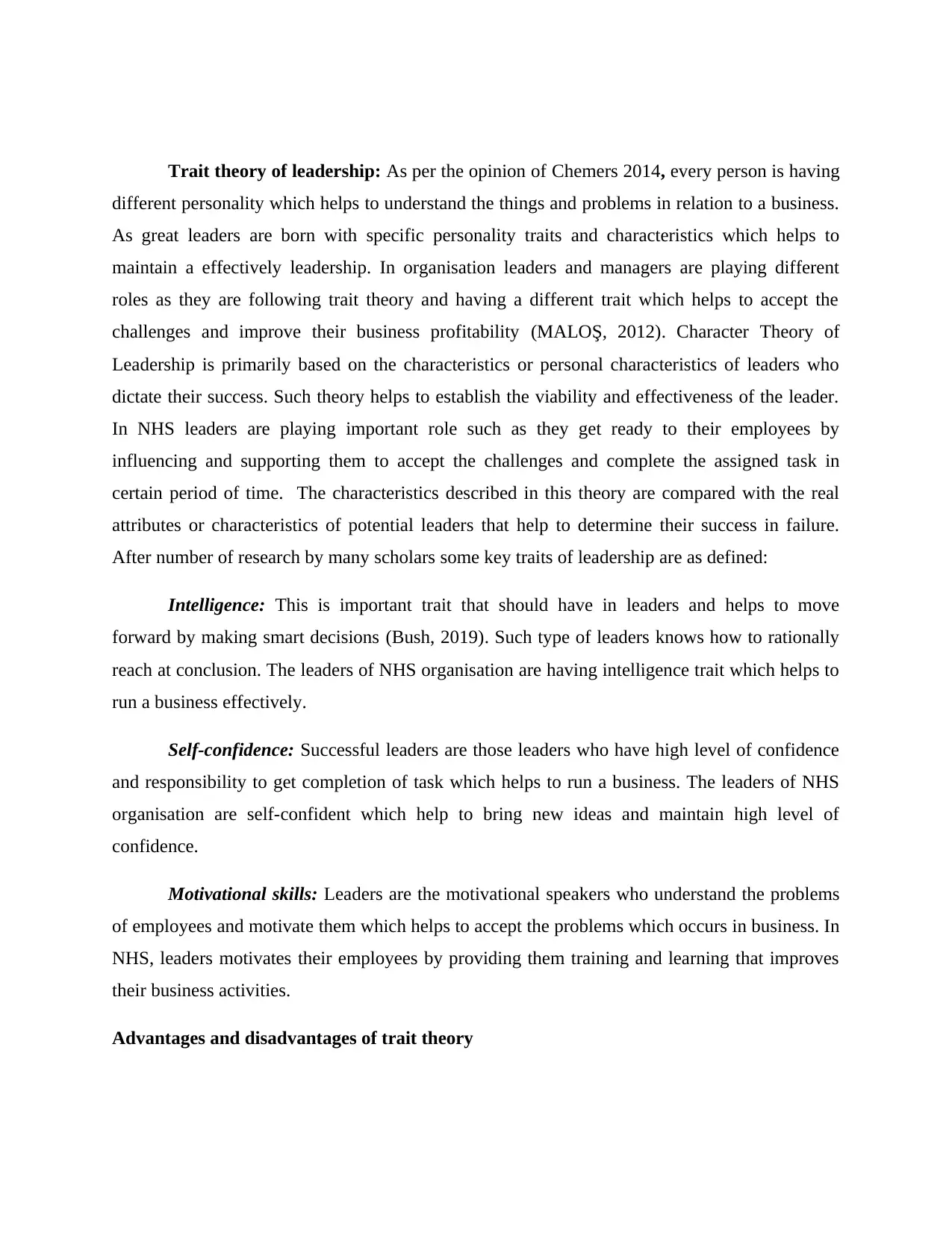
Trait theory of leadership: As per the opinion of Chemers 2014, every person is having
different personality which helps to understand the things and problems in relation to a business.
As great leaders are born with specific personality traits and characteristics which helps to
maintain a effectively leadership. In organisation leaders and managers are playing different
roles as they are following trait theory and having a different trait which helps to accept the
challenges and improve their business profitability (MALOŞ, 2012). Character Theory of
Leadership is primarily based on the characteristics or personal characteristics of leaders who
dictate their success. Such theory helps to establish the viability and effectiveness of the leader.
In NHS leaders are playing important role such as they get ready to their employees by
influencing and supporting them to accept the challenges and complete the assigned task in
certain period of time. The characteristics described in this theory are compared with the real
attributes or characteristics of potential leaders that help to determine their success in failure.
After number of research by many scholars some key traits of leadership are as defined:
Intelligence: This is important trait that should have in leaders and helps to move
forward by making smart decisions (Bush, 2019). Such type of leaders knows how to rationally
reach at conclusion. The leaders of NHS organisation are having intelligence trait which helps to
run a business effectively.
Self-confidence: Successful leaders are those leaders who have high level of confidence
and responsibility to get completion of task which helps to run a business. The leaders of NHS
organisation are self-confident which help to bring new ideas and maintain high level of
confidence.
Motivational skills: Leaders are the motivational speakers who understand the problems
of employees and motivate them which helps to accept the problems which occurs in business. In
NHS, leaders motivates their employees by providing them training and learning that improves
their business activities.
Advantages and disadvantages of trait theory
different personality which helps to understand the things and problems in relation to a business.
As great leaders are born with specific personality traits and characteristics which helps to
maintain a effectively leadership. In organisation leaders and managers are playing different
roles as they are following trait theory and having a different trait which helps to accept the
challenges and improve their business profitability (MALOŞ, 2012). Character Theory of
Leadership is primarily based on the characteristics or personal characteristics of leaders who
dictate their success. Such theory helps to establish the viability and effectiveness of the leader.
In NHS leaders are playing important role such as they get ready to their employees by
influencing and supporting them to accept the challenges and complete the assigned task in
certain period of time. The characteristics described in this theory are compared with the real
attributes or characteristics of potential leaders that help to determine their success in failure.
After number of research by many scholars some key traits of leadership are as defined:
Intelligence: This is important trait that should have in leaders and helps to move
forward by making smart decisions (Bush, 2019). Such type of leaders knows how to rationally
reach at conclusion. The leaders of NHS organisation are having intelligence trait which helps to
run a business effectively.
Self-confidence: Successful leaders are those leaders who have high level of confidence
and responsibility to get completion of task which helps to run a business. The leaders of NHS
organisation are self-confident which help to bring new ideas and maintain high level of
confidence.
Motivational skills: Leaders are the motivational speakers who understand the problems
of employees and motivate them which helps to accept the problems which occurs in business. In
NHS, leaders motivates their employees by providing them training and learning that improves
their business activities.
Advantages and disadvantages of trait theory
Paraphrase This Document
Need a fresh take? Get an instant paraphrase of this document with our AI Paraphraser
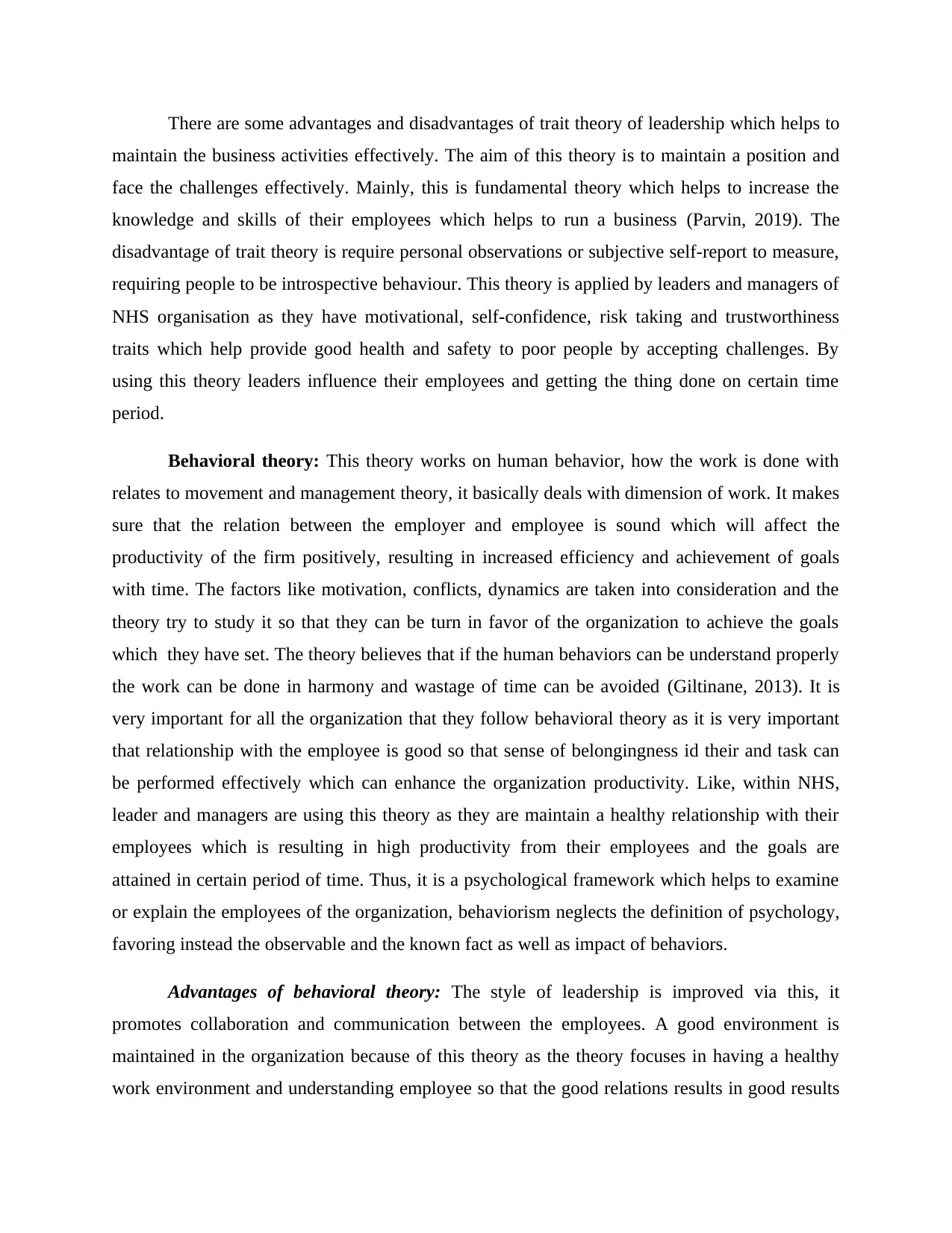
There are some advantages and disadvantages of trait theory of leadership which helps to
maintain the business activities effectively. The aim of this theory is to maintain a position and
face the challenges effectively. Mainly, this is fundamental theory which helps to increase the
knowledge and skills of their employees which helps to run a business (Parvin, 2019). The
disadvantage of trait theory is require personal observations or subjective self-report to measure,
requiring people to be introspective behaviour. This theory is applied by leaders and managers of
NHS organisation as they have motivational, self-confidence, risk taking and trustworthiness
traits which help provide good health and safety to poor people by accepting challenges. By
using this theory leaders influence their employees and getting the thing done on certain time
period.
Behavioral theory: This theory works on human behavior, how the work is done with
relates to movement and management theory, it basically deals with dimension of work. It makes
sure that the relation between the employer and employee is sound which will affect the
productivity of the firm positively, resulting in increased efficiency and achievement of goals
with time. The factors like motivation, conflicts, dynamics are taken into consideration and the
theory try to study it so that they can be turn in favor of the organization to achieve the goals
which they have set. The theory believes that if the human behaviors can be understand properly
the work can be done in harmony and wastage of time can be avoided (Giltinane, 2013). It is
very important for all the organization that they follow behavioral theory as it is very important
that relationship with the employee is good so that sense of belongingness id their and task can
be performed effectively which can enhance the organization productivity. Like, within NHS,
leader and managers are using this theory as they are maintain a healthy relationship with their
employees which is resulting in high productivity from their employees and the goals are
attained in certain period of time. Thus, it is a psychological framework which helps to examine
or explain the employees of the organization, behaviorism neglects the definition of psychology,
favoring instead the observable and the known fact as well as impact of behaviors.
Advantages of behavioral theory: The style of leadership is improved via this, it
promotes collaboration and communication between the employees. A good environment is
maintained in the organization because of this theory as the theory focuses in having a healthy
work environment and understanding employee so that the good relations results in good results
maintain the business activities effectively. The aim of this theory is to maintain a position and
face the challenges effectively. Mainly, this is fundamental theory which helps to increase the
knowledge and skills of their employees which helps to run a business (Parvin, 2019). The
disadvantage of trait theory is require personal observations or subjective self-report to measure,
requiring people to be introspective behaviour. This theory is applied by leaders and managers of
NHS organisation as they have motivational, self-confidence, risk taking and trustworthiness
traits which help provide good health and safety to poor people by accepting challenges. By
using this theory leaders influence their employees and getting the thing done on certain time
period.
Behavioral theory: This theory works on human behavior, how the work is done with
relates to movement and management theory, it basically deals with dimension of work. It makes
sure that the relation between the employer and employee is sound which will affect the
productivity of the firm positively, resulting in increased efficiency and achievement of goals
with time. The factors like motivation, conflicts, dynamics are taken into consideration and the
theory try to study it so that they can be turn in favor of the organization to achieve the goals
which they have set. The theory believes that if the human behaviors can be understand properly
the work can be done in harmony and wastage of time can be avoided (Giltinane, 2013). It is
very important for all the organization that they follow behavioral theory as it is very important
that relationship with the employee is good so that sense of belongingness id their and task can
be performed effectively which can enhance the organization productivity. Like, within NHS,
leader and managers are using this theory as they are maintain a healthy relationship with their
employees which is resulting in high productivity from their employees and the goals are
attained in certain period of time. Thus, it is a psychological framework which helps to examine
or explain the employees of the organization, behaviorism neglects the definition of psychology,
favoring instead the observable and the known fact as well as impact of behaviors.
Advantages of behavioral theory: The style of leadership is improved via this, it
promotes collaboration and communication between the employees. A good environment is
maintained in the organization because of this theory as the theory focuses in having a healthy
work environment and understanding employee so that the good relations results in good results
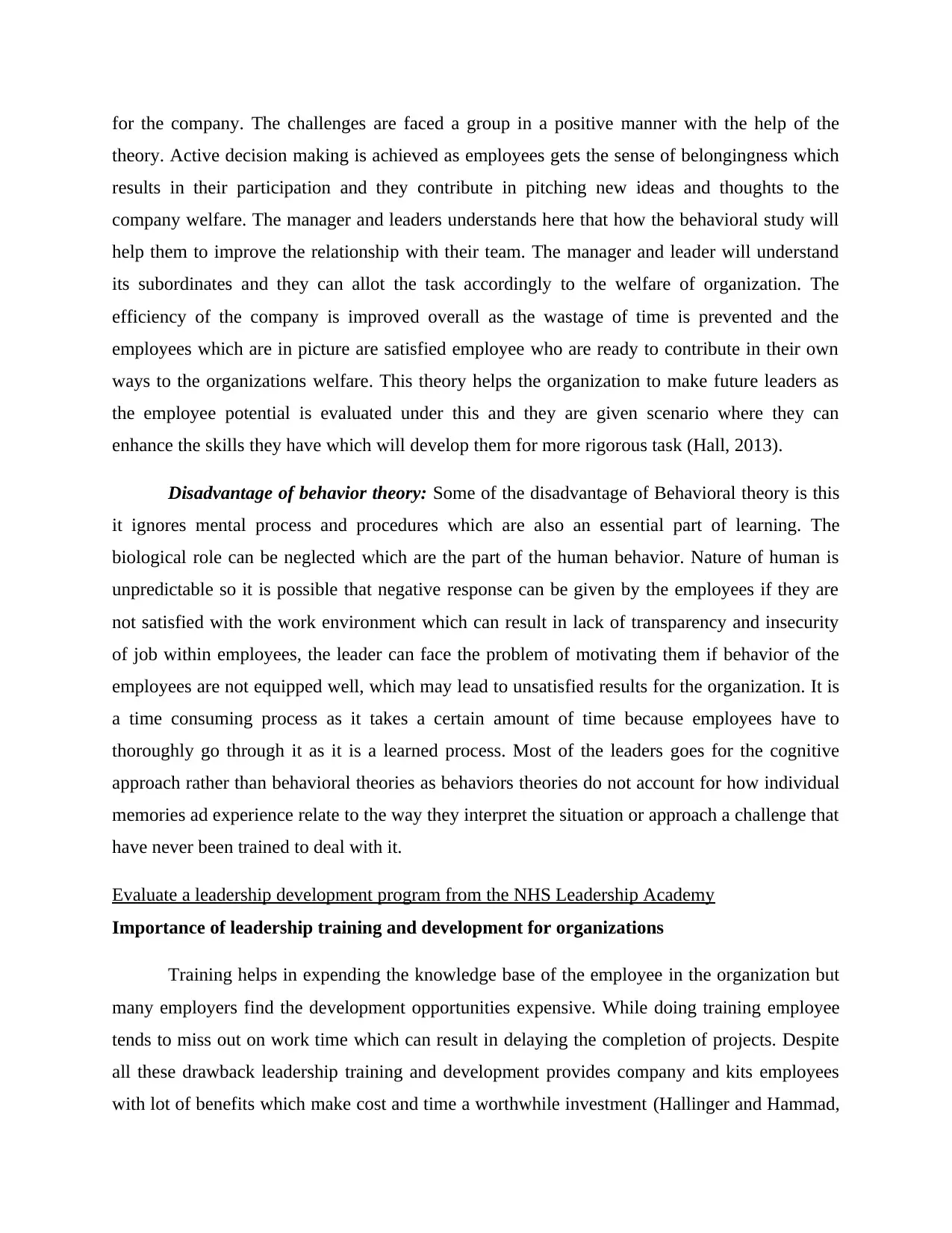
for the company. The challenges are faced a group in a positive manner with the help of the
theory. Active decision making is achieved as employees gets the sense of belongingness which
results in their participation and they contribute in pitching new ideas and thoughts to the
company welfare. The manager and leaders understands here that how the behavioral study will
help them to improve the relationship with their team. The manager and leader will understand
its subordinates and they can allot the task accordingly to the welfare of organization. The
efficiency of the company is improved overall as the wastage of time is prevented and the
employees which are in picture are satisfied employee who are ready to contribute in their own
ways to the organizations welfare. This theory helps the organization to make future leaders as
the employee potential is evaluated under this and they are given scenario where they can
enhance the skills they have which will develop them for more rigorous task (Hall, 2013).
Disadvantage of behavior theory: Some of the disadvantage of Behavioral theory is this
it ignores mental process and procedures which are also an essential part of learning. The
biological role can be neglected which are the part of the human behavior. Nature of human is
unpredictable so it is possible that negative response can be given by the employees if they are
not satisfied with the work environment which can result in lack of transparency and insecurity
of job within employees, the leader can face the problem of motivating them if behavior of the
employees are not equipped well, which may lead to unsatisfied results for the organization. It is
a time consuming process as it takes a certain amount of time because employees have to
thoroughly go through it as it is a learned process. Most of the leaders goes for the cognitive
approach rather than behavioral theories as behaviors theories do not account for how individual
memories ad experience relate to the way they interpret the situation or approach a challenge that
have never been trained to deal with it.
Evaluate a leadership development program from the NHS Leadership Academy
Importance of leadership training and development for organizations
Training helps in expending the knowledge base of the employee in the organization but
many employers find the development opportunities expensive. While doing training employee
tends to miss out on work time which can result in delaying the completion of projects. Despite
all these drawback leadership training and development provides company and kits employees
with lot of benefits which make cost and time a worthwhile investment (Hallinger and Hammad,
theory. Active decision making is achieved as employees gets the sense of belongingness which
results in their participation and they contribute in pitching new ideas and thoughts to the
company welfare. The manager and leaders understands here that how the behavioral study will
help them to improve the relationship with their team. The manager and leader will understand
its subordinates and they can allot the task accordingly to the welfare of organization. The
efficiency of the company is improved overall as the wastage of time is prevented and the
employees which are in picture are satisfied employee who are ready to contribute in their own
ways to the organizations welfare. This theory helps the organization to make future leaders as
the employee potential is evaluated under this and they are given scenario where they can
enhance the skills they have which will develop them for more rigorous task (Hall, 2013).
Disadvantage of behavior theory: Some of the disadvantage of Behavioral theory is this
it ignores mental process and procedures which are also an essential part of learning. The
biological role can be neglected which are the part of the human behavior. Nature of human is
unpredictable so it is possible that negative response can be given by the employees if they are
not satisfied with the work environment which can result in lack of transparency and insecurity
of job within employees, the leader can face the problem of motivating them if behavior of the
employees are not equipped well, which may lead to unsatisfied results for the organization. It is
a time consuming process as it takes a certain amount of time because employees have to
thoroughly go through it as it is a learned process. Most of the leaders goes for the cognitive
approach rather than behavioral theories as behaviors theories do not account for how individual
memories ad experience relate to the way they interpret the situation or approach a challenge that
have never been trained to deal with it.
Evaluate a leadership development program from the NHS Leadership Academy
Importance of leadership training and development for organizations
Training helps in expending the knowledge base of the employee in the organization but
many employers find the development opportunities expensive. While doing training employee
tends to miss out on work time which can result in delaying the completion of projects. Despite
all these drawback leadership training and development provides company and kits employees
with lot of benefits which make cost and time a worthwhile investment (Hallinger and Hammad,
⊘ This is a preview!⊘
Do you want full access?
Subscribe today to unlock all pages.

Trusted by 1+ million students worldwide
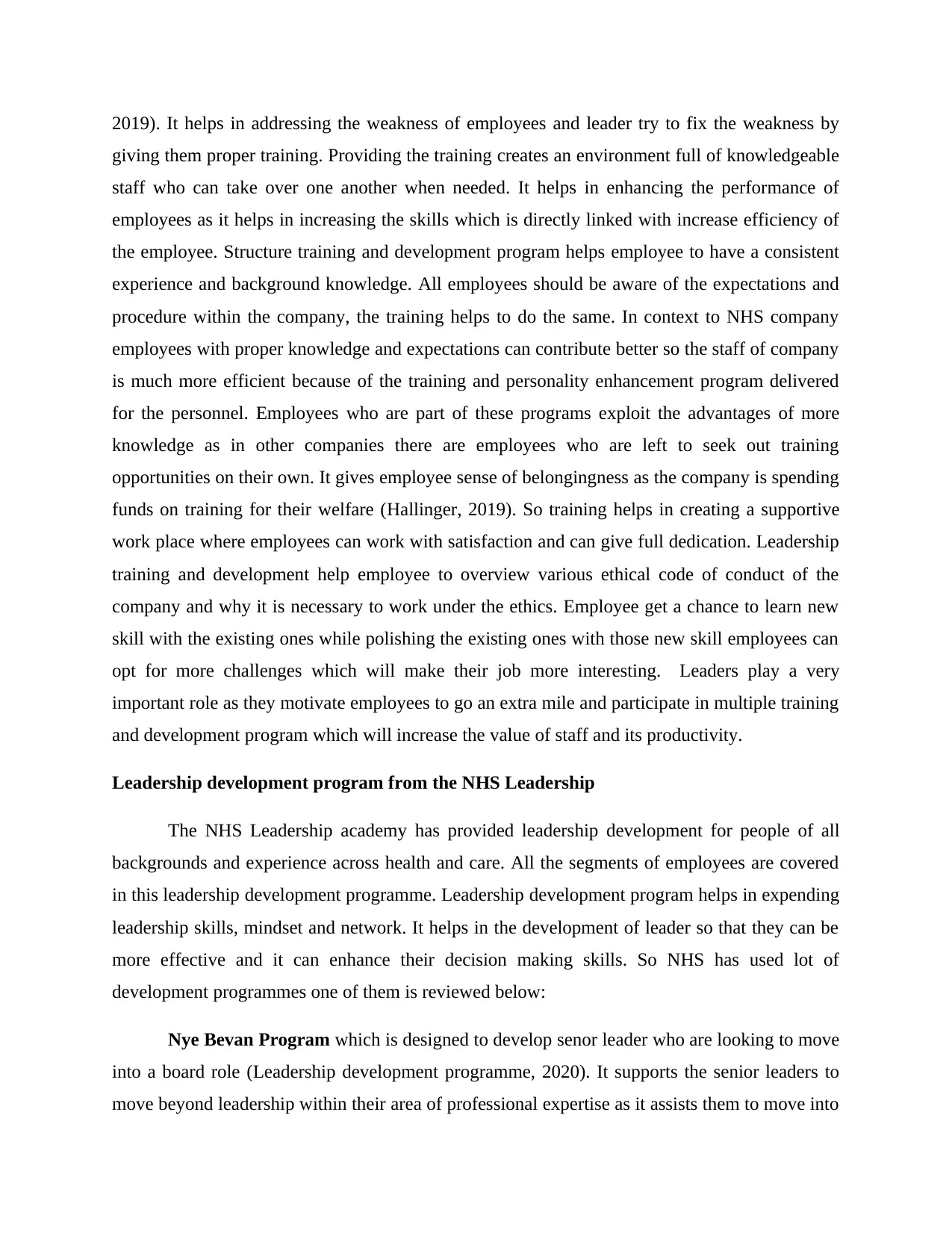
2019). It helps in addressing the weakness of employees and leader try to fix the weakness by
giving them proper training. Providing the training creates an environment full of knowledgeable
staff who can take over one another when needed. It helps in enhancing the performance of
employees as it helps in increasing the skills which is directly linked with increase efficiency of
the employee. Structure training and development program helps employee to have a consistent
experience and background knowledge. All employees should be aware of the expectations and
procedure within the company, the training helps to do the same. In context to NHS company
employees with proper knowledge and expectations can contribute better so the staff of company
is much more efficient because of the training and personality enhancement program delivered
for the personnel. Employees who are part of these programs exploit the advantages of more
knowledge as in other companies there are employees who are left to seek out training
opportunities on their own. It gives employee sense of belongingness as the company is spending
funds on training for their welfare (Hallinger, 2019). So training helps in creating a supportive
work place where employees can work with satisfaction and can give full dedication. Leadership
training and development help employee to overview various ethical code of conduct of the
company and why it is necessary to work under the ethics. Employee get a chance to learn new
skill with the existing ones while polishing the existing ones with those new skill employees can
opt for more challenges which will make their job more interesting. Leaders play a very
important role as they motivate employees to go an extra mile and participate in multiple training
and development program which will increase the value of staff and its productivity.
Leadership development program from the NHS Leadership
The NHS Leadership academy has provided leadership development for people of all
backgrounds and experience across health and care. All the segments of employees are covered
in this leadership development programme. Leadership development program helps in expending
leadership skills, mindset and network. It helps in the development of leader so that they can be
more effective and it can enhance their decision making skills. So NHS has used lot of
development programmes one of them is reviewed below:
Nye Bevan Program which is designed to develop senor leader who are looking to move
into a board role (Leadership development programme, 2020). It supports the senior leaders to
move beyond leadership within their area of professional expertise as it assists them to move into
giving them proper training. Providing the training creates an environment full of knowledgeable
staff who can take over one another when needed. It helps in enhancing the performance of
employees as it helps in increasing the skills which is directly linked with increase efficiency of
the employee. Structure training and development program helps employee to have a consistent
experience and background knowledge. All employees should be aware of the expectations and
procedure within the company, the training helps to do the same. In context to NHS company
employees with proper knowledge and expectations can contribute better so the staff of company
is much more efficient because of the training and personality enhancement program delivered
for the personnel. Employees who are part of these programs exploit the advantages of more
knowledge as in other companies there are employees who are left to seek out training
opportunities on their own. It gives employee sense of belongingness as the company is spending
funds on training for their welfare (Hallinger, 2019). So training helps in creating a supportive
work place where employees can work with satisfaction and can give full dedication. Leadership
training and development help employee to overview various ethical code of conduct of the
company and why it is necessary to work under the ethics. Employee get a chance to learn new
skill with the existing ones while polishing the existing ones with those new skill employees can
opt for more challenges which will make their job more interesting. Leaders play a very
important role as they motivate employees to go an extra mile and participate in multiple training
and development program which will increase the value of staff and its productivity.
Leadership development program from the NHS Leadership
The NHS Leadership academy has provided leadership development for people of all
backgrounds and experience across health and care. All the segments of employees are covered
in this leadership development programme. Leadership development program helps in expending
leadership skills, mindset and network. It helps in the development of leader so that they can be
more effective and it can enhance their decision making skills. So NHS has used lot of
development programmes one of them is reviewed below:
Nye Bevan Program which is designed to develop senor leader who are looking to move
into a board role (Leadership development programme, 2020). It supports the senior leaders to
move beyond leadership within their area of professional expertise as it assists them to move into
Paraphrase This Document
Need a fresh take? Get an instant paraphrase of this document with our AI Paraphraser
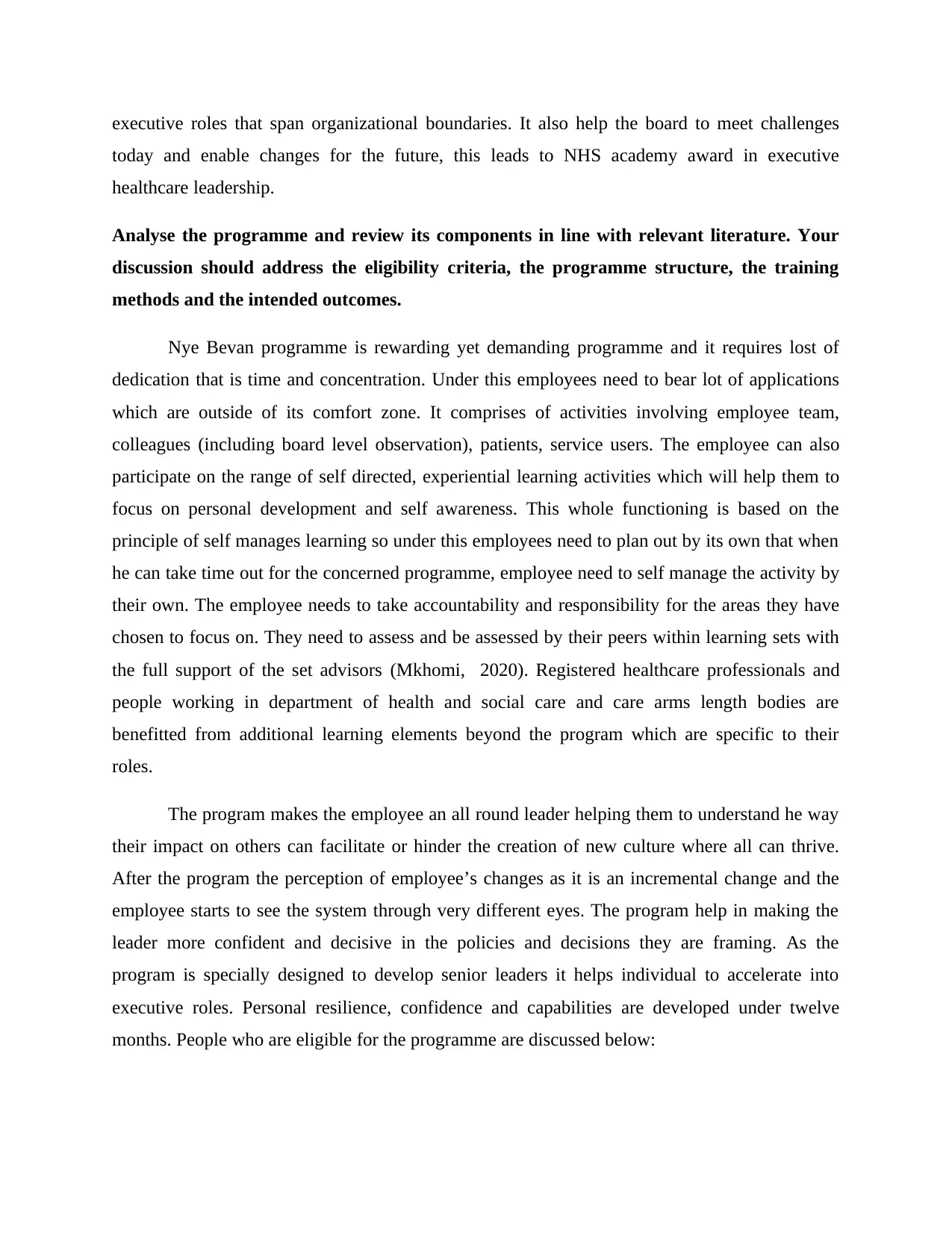
executive roles that span organizational boundaries. It also help the board to meet challenges
today and enable changes for the future, this leads to NHS academy award in executive
healthcare leadership.
Analyse the programme and review its components in line with relevant literature. Your
discussion should address the eligibility criteria, the programme structure, the training
methods and the intended outcomes.
Nye Bevan programme is rewarding yet demanding programme and it requires lost of
dedication that is time and concentration. Under this employees need to bear lot of applications
which are outside of its comfort zone. It comprises of activities involving employee team,
colleagues (including board level observation), patients, service users. The employee can also
participate on the range of self directed, experiential learning activities which will help them to
focus on personal development and self awareness. This whole functioning is based on the
principle of self manages learning so under this employees need to plan out by its own that when
he can take time out for the concerned programme, employee need to self manage the activity by
their own. The employee needs to take accountability and responsibility for the areas they have
chosen to focus on. They need to assess and be assessed by their peers within learning sets with
the full support of the set advisors (Mkhomi, 2020). Registered healthcare professionals and
people working in department of health and social care and care arms length bodies are
benefitted from additional learning elements beyond the program which are specific to their
roles.
The program makes the employee an all round leader helping them to understand he way
their impact on others can facilitate or hinder the creation of new culture where all can thrive.
After the program the perception of employee’s changes as it is an incremental change and the
employee starts to see the system through very different eyes. The program help in making the
leader more confident and decisive in the policies and decisions they are framing. As the
program is specially designed to develop senior leaders it helps individual to accelerate into
executive roles. Personal resilience, confidence and capabilities are developed under twelve
months. People who are eligible for the programme are discussed below:
today and enable changes for the future, this leads to NHS academy award in executive
healthcare leadership.
Analyse the programme and review its components in line with relevant literature. Your
discussion should address the eligibility criteria, the programme structure, the training
methods and the intended outcomes.
Nye Bevan programme is rewarding yet demanding programme and it requires lost of
dedication that is time and concentration. Under this employees need to bear lot of applications
which are outside of its comfort zone. It comprises of activities involving employee team,
colleagues (including board level observation), patients, service users. The employee can also
participate on the range of self directed, experiential learning activities which will help them to
focus on personal development and self awareness. This whole functioning is based on the
principle of self manages learning so under this employees need to plan out by its own that when
he can take time out for the concerned programme, employee need to self manage the activity by
their own. The employee needs to take accountability and responsibility for the areas they have
chosen to focus on. They need to assess and be assessed by their peers within learning sets with
the full support of the set advisors (Mkhomi, 2020). Registered healthcare professionals and
people working in department of health and social care and care arms length bodies are
benefitted from additional learning elements beyond the program which are specific to their
roles.
The program makes the employee an all round leader helping them to understand he way
their impact on others can facilitate or hinder the creation of new culture where all can thrive.
After the program the perception of employee’s changes as it is an incremental change and the
employee starts to see the system through very different eyes. The program help in making the
leader more confident and decisive in the policies and decisions they are framing. As the
program is specially designed to develop senior leaders it helps individual to accelerate into
executive roles. Personal resilience, confidence and capabilities are developed under twelve
months. People who are eligible for the programme are discussed below:
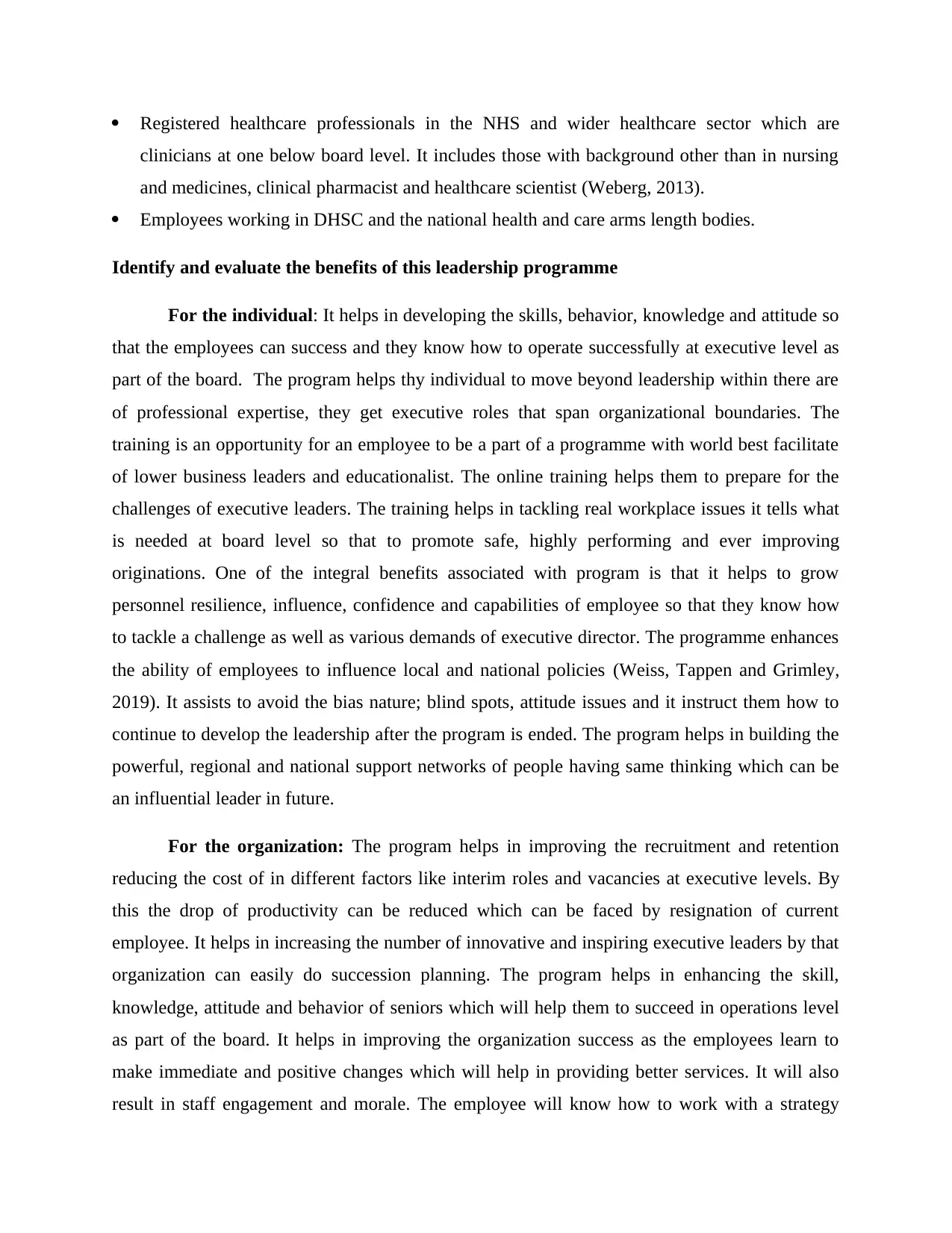
Registered healthcare professionals in the NHS and wider healthcare sector which are
clinicians at one below board level. It includes those with background other than in nursing
and medicines, clinical pharmacist and healthcare scientist (Weberg, 2013).
Employees working in DHSC and the national health and care arms length bodies.
Identify and evaluate the benefits of this leadership programme
For the individual: It helps in developing the skills, behavior, knowledge and attitude so
that the employees can success and they know how to operate successfully at executive level as
part of the board. The program helps thy individual to move beyond leadership within there are
of professional expertise, they get executive roles that span organizational boundaries. The
training is an opportunity for an employee to be a part of a programme with world best facilitate
of lower business leaders and educationalist. The online training helps them to prepare for the
challenges of executive leaders. The training helps in tackling real workplace issues it tells what
is needed at board level so that to promote safe, highly performing and ever improving
originations. One of the integral benefits associated with program is that it helps to grow
personnel resilience, influence, confidence and capabilities of employee so that they know how
to tackle a challenge as well as various demands of executive director. The programme enhances
the ability of employees to influence local and national policies (Weiss, Tappen and Grimley,
2019). It assists to avoid the bias nature; blind spots, attitude issues and it instruct them how to
continue to develop the leadership after the program is ended. The program helps in building the
powerful, regional and national support networks of people having same thinking which can be
an influential leader in future.
For the organization: The program helps in improving the recruitment and retention
reducing the cost of in different factors like interim roles and vacancies at executive levels. By
this the drop of productivity can be reduced which can be faced by resignation of current
employee. It helps in increasing the number of innovative and inspiring executive leaders by that
organization can easily do succession planning. The program helps in enhancing the skill,
knowledge, attitude and behavior of seniors which will help them to succeed in operations level
as part of the board. It helps in improving the organization success as the employees learn to
make immediate and positive changes which will help in providing better services. It will also
result in staff engagement and morale. The employee will know how to work with a strategy
clinicians at one below board level. It includes those with background other than in nursing
and medicines, clinical pharmacist and healthcare scientist (Weberg, 2013).
Employees working in DHSC and the national health and care arms length bodies.
Identify and evaluate the benefits of this leadership programme
For the individual: It helps in developing the skills, behavior, knowledge and attitude so
that the employees can success and they know how to operate successfully at executive level as
part of the board. The program helps thy individual to move beyond leadership within there are
of professional expertise, they get executive roles that span organizational boundaries. The
training is an opportunity for an employee to be a part of a programme with world best facilitate
of lower business leaders and educationalist. The online training helps them to prepare for the
challenges of executive leaders. The training helps in tackling real workplace issues it tells what
is needed at board level so that to promote safe, highly performing and ever improving
originations. One of the integral benefits associated with program is that it helps to grow
personnel resilience, influence, confidence and capabilities of employee so that they know how
to tackle a challenge as well as various demands of executive director. The programme enhances
the ability of employees to influence local and national policies (Weiss, Tappen and Grimley,
2019). It assists to avoid the bias nature; blind spots, attitude issues and it instruct them how to
continue to develop the leadership after the program is ended. The program helps in building the
powerful, regional and national support networks of people having same thinking which can be
an influential leader in future.
For the organization: The program helps in improving the recruitment and retention
reducing the cost of in different factors like interim roles and vacancies at executive levels. By
this the drop of productivity can be reduced which can be faced by resignation of current
employee. It helps in increasing the number of innovative and inspiring executive leaders by that
organization can easily do succession planning. The program helps in enhancing the skill,
knowledge, attitude and behavior of seniors which will help them to succeed in operations level
as part of the board. It helps in improving the organization success as the employees learn to
make immediate and positive changes which will help in providing better services. It will also
result in staff engagement and morale. The employee will know how to work with a strategy
⊘ This is a preview!⊘
Do you want full access?
Subscribe today to unlock all pages.

Trusted by 1+ million students worldwide
1 out of 15
Related Documents
Your All-in-One AI-Powered Toolkit for Academic Success.
+13062052269
info@desklib.com
Available 24*7 on WhatsApp / Email
![[object Object]](/_next/static/media/star-bottom.7253800d.svg)
Unlock your academic potential
Copyright © 2020–2025 A2Z Services. All Rights Reserved. Developed and managed by ZUCOL.




